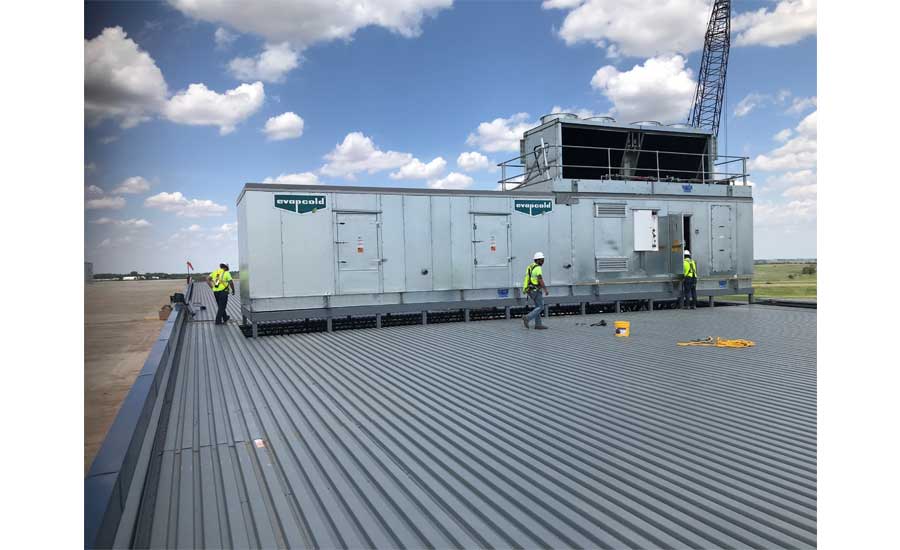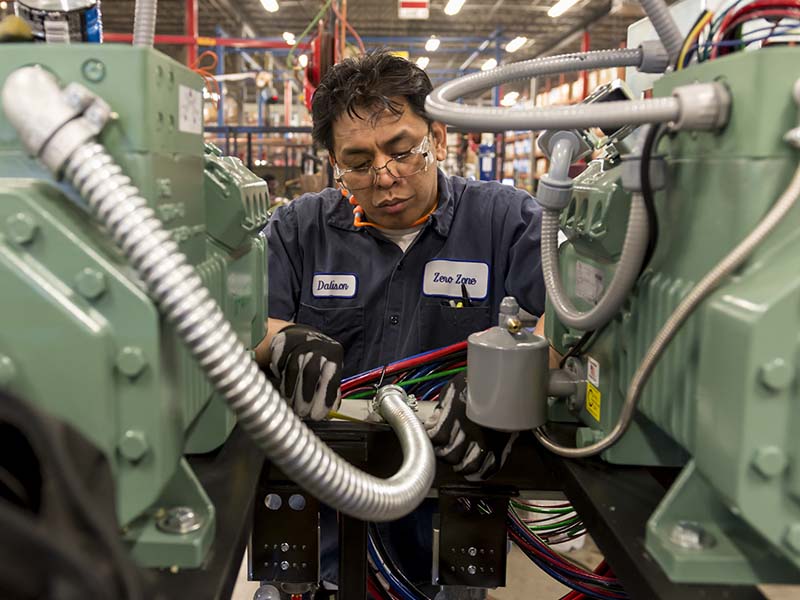The cold storage market is heating up
One of the interesting trends brought about by the pandemic is the skyrocketing demand for cold storage warehouses. And this trend is significant, according to consulting company Emergen Research, which reports that the global cold storage construction market is expected to reach $18.6 billion in 2027, up from $7 billion in 2019.
This market revenue growth has primarily been driven by increased online grocery sales and expanded e-commerce channels, which flourished during the pandemic, resulting in the need to expand cold storage facilities. The report predicts that demand for processed and fresh products through online channels will continue to drive market growth, which is good news for refrigeration contractors, who may be able to leverage this demand into more business for their companies.

COOL INSTALL: An Evapcold LCR-P air-cooled, 70-ton, low-charge ammonia, penthouse unit is shown being installed on a 133,000-sq-ft Lineage Logistics cold storage facility. (Courtesy of Evapco)
Increased Demand
While the shift to e-commerce has increased demand for cold storage facilities, there are other driving forces as well, including existing facilities reaching maximum capacity and an aging infrastructure, said Brian Kelly, industrial refrigeration sales director for Danfoss Climate Solutions. He added that the trend is also being driven by years of underinvestment in the cold storage real estate market due to prohibited speculative development opportunities.
“We’ve seen the largest growth at facilities that deal in food distribution and direct-to-consumer at the national level,” said Kelly. “The demand is coming from cold storage operators at both new construction and retrofitted existing facilities. When retrofitting existing facilities, operators are seeking to increase their refrigeration capacity and improve system efficiency.”
The increased demand for cold storage facilities in the U.S. and Canada is significant, agreed Kurt Liebendorfer, vice president at EVAPCO Inc., who noted that his company has seen a substantial increase in cold storage retrofit and construction work over the last year. Aging cold storage facilities and rapid growth of e-commerce that now includes frozen and refrigerated foods are primarily driving the increase around the country, but particularly in urban areas such as Denver, Houston, Phoenix, and Dallas.
“In addition, there is a lot of new investment and acquisitions taking place in the cold storage market,” he said. “Lineage Logistics is a good example, where they have acquired dozens of cold storage companies and facilities in just the last couple of years. They’ve also initiated a lot of new construction as well. This new investment money has also led to new entries into the cold storge construction market by large commercial architectural engineering (AE) firms, general contractors (GCs), and REITS (real estate investment trusts).”
Another issue driving growth is that a growing number of consumers are expecting fresh or perishable food that is ready to serve/cook all year-round, and they are also demanding a greater variety of foods, said John Collins PE, industrial sales manager-east at Zero Zone Inc., Systems Division.
“Retailers are responding to this demand and capitalizing on the opportunity to increase revenue and profit by delivering what their customers see as higher value product for which they are willing to pay more,” he said. “To provide these products, producers and retailers need a more extensive and robust cold chain to support the consumer demand. This shift in expectations and the demand for ever more options in the choices we have as consumers is driving changes and growth in the entire cold chain.”
Choices and Considerations
Since each cold storage facility is custom-built to fit specific design requirements, the type of refrigeration equipment used can vary from one facility to the next, said Kelly. When it comes to choosing which type of refrigeration and/or control system to install, however, cold storage operators generally take three key issues into consideration.
“First, they’re evaluating the end user’s existing controls and the capability of the current system (e.g., performance and capability limitations, longevity of the system in place, age of technology),” he said. “Second, they’re considering the potential improvements in energy efficiency, performance, and capabilities of the new system over the existing system. Lastly, food safety and regulatory compliance remain critical issues for operators.”
To that last point, temperature control is a critical issue in cold storage facilities, but the system’s cost and complexity can also play a large role in deciding which refrigeration system to use. As such, most end users need to find a balance between initial construction cost and overall life cycle cost of the refrigeration system, as well as complexity, said Collins.
“For example, an inexperienced facilities operator may prefer a simpler system with less sophisticated controls, and more conventional equipment may be preferred over a system that brings the benefits of newer technologies but more complex refrigeration equipment,” he said.
Probably the most common type of refrigeration system that is utilized in the cold storage industry is the central plant recirculated ammonia system, said Liebendorfer. This equipment has been used for over 50 years due to its reliability, flexibility, energy efficiency, and cost effectiveness, and it still enjoys widespread use, he said.
“However, over the last decade, the industry has experienced its own technology revolution on several fronts,” he said. “Though core refrigeration equipment hasn’t changed radically – components of evaporators, compressors, condensers, and pressure vessels remain the fundamental building blocks — the way they are put together, fabricated, piped, packaged, controlled, managed, and monitored has changed substantially. Material science has also advanced. For example, at EVAPCO, we offer improved heat transfer technology and corrosion protection by utilizing enhanced stainless steel heat transfer surfaces.”
Refrigerant type is also a fundamental consideration in the choice of a refrigeration system, said Collins. “With HFCs and other synthetic refrigerants, the materials of construction and components are different than for natural refrigerants such as ammonia or carbon dioxide. The capabilities and training for the operators of refrigeration systems varies greatly with the choice of refrigerant.”
Regulatory Issues
Speaking of refrigerants, the impending phasedown of HFCs will likely have an impact on how cold storage facilities are designed, built, and operated in the near future — particularly for smaller cold storage facilities that are less than 50,000 square feet, as these were primarily built with split systems using HFC refrigerants, said Kelly. These split systems are also commercial-grade — as opposed to industrial-grade — and will be at their end of life over the next five to 10 years.

NATURAL MOVE: Zero Zone expects cold storage facility operators will move toward natural refrigerants such as carbon dioxide, due to new regulations. Here, a technician works on a CO2 rack assembly. (Courtesy of Zero Zone)
“With the regulatory changes occurring in refrigeration, operators are feeling more pressure to transition away from higher-GWP refrigerants to other alternatives,” said Collins. “This is driving decisions and creating significant change in the type of systems we are providing for our refrigerated facilities today. There is a move toward natural refrigerants, especially carbon dioxide in recent years, which is dramatically increasing the number of these systems now being installed across the U.S. and in other countries.”
Liebendorfer also expects the HFC phasedown to increase interest in CO2 and ammonia refrigeration systems, noting that cold storage facility operators will have to make decisions about retrofitting/removing high-GWP refrigerants in exchange for new, natural refrigerant refrigeration systems — or else abandoning older facilities in favor of new construction.
With the impending regulatory changes and greater customer demand, Liebendorfer expects the growth of cold storage facilities will continue until supply catches up with demand, including the addition of some needed backup capacity.
“The last decade has seen cold storage capacity that is short of demand, and this has been increasing as the legacy facilities continue to age and reach the end of their useful life,” he said. “The pandemic also put a spotlight on the fact that the cold storage market has limited redundancy or excess capacity — as illustrated by the supply disruptions over the last year.”
This, along with the continuing need to respond to evolving demands and expectations from customers and adapt to changing logistical and regulatory requirements, is driving continued growth and development in refrigeration technology and equipment, said Collins. But for all this to occur, a skilled workforce is necessary.
“A key factor in meeting the refrigeration needs of the industry going forward will be the availability of skilled and knowledgeable professionals who can design, build, and operate systems with the new technologies of today,” said Collins.
August 18, 2021
Joanna R. Turpin
https://www.achrnews.com/articles/145371-growing-demand-in-cold-storage-market-is-great-opportunity-for-refrigeration-contractors

